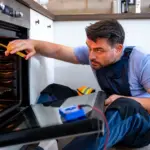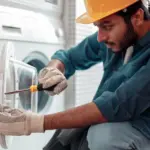Have you ever had an appliance failure at the most inconvenient time? We’ve all been there. That is the same feeling almost anyone gets when the refrigerator ceases to cool or the washing machine will not pump out. However, it would be more appealing to repair it yourself. Most home appliances’ issues can be fixed without the help of a technician. Here are real-life recommendations that are simple, effective, and designed to help you get more done, spend less, and avoid stress.
Understanding Common Appliance Issues
Any appliance will give you warning signs before it stops working altogether. It also means that by understanding what kind of signs can indicate that there is a problem, and how to address minor incidents ahead of time, it is possible to prevent such issues from getting worse or developing in the first place. Here are some common types of problems homeowners face with their home appliances, and how you can fix them yourself.
Refrigerators: Cooling Problems and Solutions
Your refrigerator is a key appliance in your kitchen— when it decides to give up, it’s a biggie.
- Common Fridge Not Cooling Issues
Perhaps the most frequent is when the appliance is not freezing or cooling as it is supposed to do. Begin with regulating the thermometer temperatures. If the settings are ok then it could be time to clean the condenser coils if they are dirty. Coolant-impregnated coils reduce airflow and contribute to cooling problems. It may be vacuumed or you may want to use a coil brush to clean them.
- How to Fix a Leaking Refrigerator
A blocked defrost drain is one of the causes of a leaking fridge. Most of the time, this occurs whenever foreign materials such as food debris or ice block the drain pipeline. If this is the case, you should try looking at the drain from inside the fridge and pour warm water over it, or use a pipe cleaner to have the debris cleared off. If the leak does not stop, then check the water filter as if it may be loose or it may have gone bad.
Washing Machines: Fixing Drainage and Spin Issues
How many of you have been in a calamity on laundry day because of a non-working washing machine? However, it is surprising that many normal washer issues are soluble.
- Washer Not Draining: Simple Fixes
If your washing machine is not draining, to begin with, the drainage pipe is the first area to look at. It might have been kinked or was clogged by lint. If the hose looks all right, then there might be some problem with the pump filter. You should be able to clean out any junk from it and that should be enough to fix it. Also, check if the lid switch is working properly or not as the lights on it are indicating. If one of them is broken the machine will not be able to drain.
- What to Do When Your Washer Won’t Spin
An unbalanced load is one of the main reasons why a washer won’t spin or rotate as it’s supposed to. Perhaps, attempt to spread the clothes uniformly in the drum. If that does not solve the problem, the motor coupling could be a source of the problem, which is the connection between the motor and the drum.
Ovens: Heating Problems and Malfunctioning Burners
When your oven is not heating, cooking a meal becomes impossible.
- Why Won’t the Oven Heat Up?
In most cases, when your oven cannot heat up, it is either the heating element having a problem with it. When an element is faulty, it will not allow your oven to get the right temperature for cooking. To verify, look at the element for signs of wear and tear, for instance, any splits or signs of burning. If it’s damaged, replace it.
- Fixing a Burner That Won’t Light
If a burner fails to ignite then the problem can be in the igniter or the burner head becoming dirty. Look through the screen at the burner head and use a soft brush to wipe it clean because any residue can interfere with the igniter if there is food in the way.
Essential Tools for Appliance Repair
In any repair job, you must prepare your tools before actually repairing. Any home appliance technician should have these simple items on hand: a multimeter for testing electric circuits or components, a flat-head screwdriver, a Phillips head screwdriver, pliers, and a wrench kit. It is also comforting to have a socket set as well as an adjustable wrench around.
When it comes to fixing appliances, there should be no reason which makes it complicated. The question remains, why spend money on repairing your appliances, investing in spare parts, or even buying new ones when you can learn how to maintain your appliances effectively? Next time your fridge starts leaking, or your washer stops spinning, use the following tips before you call an expert. Who knew some of these things could be fixed right in the comfort of your home?



